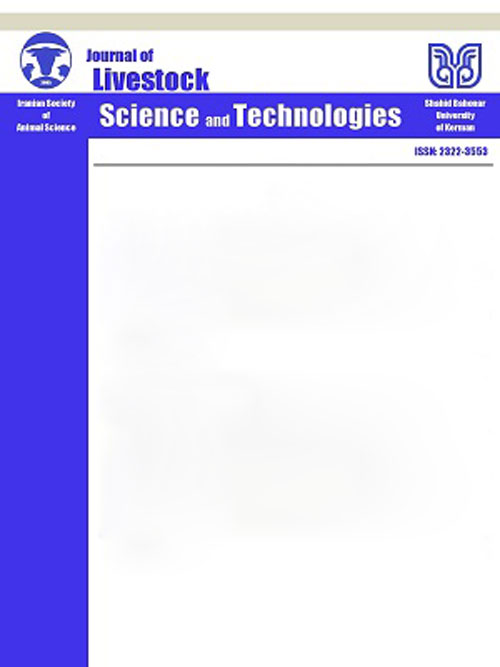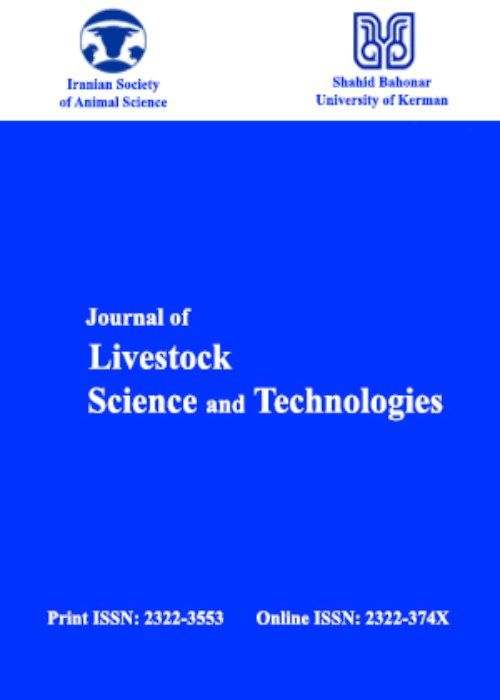فهرست مطالب

Journal of Livestock Science and Technology
Volume:5 Issue: 2, Dec 2017
- تاریخ انتشار: 1396/09/26
- تعداد عناوین: 9
-
-
Pages 1-9A ten-week experiment was conducted to study the effect of a nanostructure of phytic acid absorber (NPAA) on the performance and protein digestibility in laying hens. A total of 100 Bovans laying hens were randomly assigned to 5 treatments, with 4 replicates, 5 hens each. The experiment was a completely randomized design with 5 levels of NPAA; including zero (T1, as a basal diet (BD)); T2 (BD 0.5% NPAA); T3 (BD 0.25% NPAA); T4 (BD 0.0625% NPAA) and T5 (BD 0.03125% NPAA of total P) in diet. Water and feed were offered ad libitum. Inclusion of NPAA to the diet had significant effects (PKeywords: egg production, birds, phytate phosphorus, egg shell, bovans
-
Pages 11-17This study was carried out to measure the prececal protein and ether extract digestibility of shrimp and fish meal using the regression approach. A total of 280 Cobb 500 day-old broilers (mixed sexes) were randomly allotted to 7 treatment groups (4 replicates of 10 broilers each) in a completely randomized design. Feed intake was higher in the birds that received protease-supplemented shrimp meal and fish meal compared to the 4% raw shrimp meal and basal diets (PKeywords: broiler, fish meal, digestibility, Performance, shrimp meal
-
Pages 19-27In the present study, twenty-five male goat kids (20±2.5 kg BW) were used during an 84- day experimental period to determine the effect of source and level of sulfur supplementation on mohair characteristics and performance. Experimental diets were diets containing 0.18% (as control), 0.24% and 0.34% DM inorganic or organic sulfur. The data were analyzed as a 2 × 2 factorial design. Methionine and sulfur flower were used as organic and inorganic sources of sulfur, respectively. Diets containing inorganic sulfur increased greasy and clean mohair production and staple length when compared with organic sulfur (PKeywords: goat kids, sulfur supplementation, Mohair characteristics, Performance
-
Pages 29-34Freezing of ejaculated and epididymal spermatozoa is currently a subject of interest with the purpose of establishing an efficient gene banking model for valuable animals or endangered species. Therefore, the present study evaluated the influence of different storage duration )0, 1.5 and 5 h) at 5 ºC and type of cryoprotectant on freezability of ram epididymal spermatozoa. With increasing the storage duration from 0 to 3 h at 5 ºC, the motility, progressive motility, viability and recovery rate of stored spermatozoa decreased (P0.05). Addition of trehalose and sucrose to the basic diluent improved (PKeywords: Epididymis, Spermatozoa, Ram, Freezing, Antioxidant
-
Pages 35-41A total of 989,582 test-day records of 160,243 first-parity cows collected from 131 herds of Iranian Holstein dairy cows from 1995 to 2014 by the Animal Breeding and Improvement Centre of Iran, were used to determine the best model for lactation curves of fat to protein ratio (FPR) and somatic cell scores (SCS) in the first lactation. Several mathematical models including the Wood (WD), Wilmink (WL), Rook (RK), Dijkstra (DJ), Narushin-Takma (NT) and Ali and Schaeffer (AS) functions were fitted and compared by four comparison measures; adjusted coefficient of determination (R2adj), residual standard deviation (RSD), Akaike's information criterion (AIC) and Durbin-Watson statistic (DW). The NT function was the best model for describing the lactation curves of FPR and SCS in terms of higher R2adj and lower RSD and AIC. The calculated values of DW for FPR and SCS under NT function were 1.99 and 1.86, respectively; implying that the existence of positive autocorrelation between residuals was not important for these traits. The Pearson's correlation coefficients between the actual and predicted records of SCS and FPR values were 0.98 and 0.99 (PKeywords: non, linear models, goodness of fit, milk constituents, Holsteins
-
Pages 43-52The objective of this study was to evaluate the imputation accuracy of parent-offspring trios under different scenarios. By using simulated datasets, the performance Bayesian LASSO in genomic prediction was also examined. The genome consisted of 5 chromosomes and each chromosome was set as 1 Morgan length. The number of SNPs per chromosome was 10000. One hundred QTLs were randomly distributed across chromosomes. Three low density SNP panels, containing 0.5k, 1k and 5k SNPs, were generated from the 10k panel. Six scenarios were evaluated, each containing two trios (dam, sire and offspring) and sire of each dam for parent-offspring pair data. These scenarios were compared from completely genotyped offspring to low-density genotyped and dams that were completely genotyped, low density genotyped and non-genotyped. It was assumed that the genotypes of the offsprings sires were available. The Beagle 3.3.2 program was used for imputation of parent-offspring trios. The Bayesian LASSO were used to estimate the marker effects using the R package of BLR. The results showed that accuracy of both imputation and genomic evaluation was influenced by imputation errors. Imputation accuracy ranged from 0.67 to 0.96 for genotyped individuals. Genotype imputation accuracy increased with increasing marker density of low-density genotyping platform and with dams having high-density genotypes. Results showed that imputation accuracies decreased significantly (PKeywords: Low, density, genotype imputation, genotyped individuals, Non, genotyped, Scenario
-
Pages 53-61The artificial neural networks, the learning algorithms and mathematical models mimicking the information processing ability of human brain can be used non-linear and complex data. The aim of this study was to predict the breeding values for milk production trait in Iranian Holstein cows applying artificial neural networks. Data on 35167 Iranian Holstein cows recorded between 1998 to 2009 were obtained from the Animal Breeding Center of Iran. Breeding values for the milk production trait were determined using the ASReml univariate animal model with 70% of all data used as training data, 15% as testing data and 15% as validating data, to prevent over-fitting of the artificial neural network. A feed-forward backpropagation multilayer perceptron algorithm with three-layer MLP; including 1 input layer, 1 hidden layer and 1 output layer and four-layer MLP; including 1 input layer, 2 hidden layer and 1 output layer was used. The most influential parameters for input characters in artificial neural network were sire, herd, calving year, twice-daily milking (Milk 2x), calving season and age based month. Breeding values for milk production was used as variable output. For network with 4 layers, the best selected structure for the first lactation trait contained input layers with 6 neurons, first hidden layer with 16 neurons and with 68 epoch, second hidden layer with 6 neurons and with 154 epoch and output layer with 1 neuron. The capability of artificial neural network model was higher and closer to the estimated breeding values; therefore it is possible to apply artificial neural networks, instead of commonly-used procedures for predicting the breeding values for milk production.Keywords: artificial neural networks, breeding value, milk production, Iranian Holstein cows
-
Pages 63-73Domestication and selection are processes that conserve the pattern of genetic diversities between and within populations. Identification of genomic regions that are targets of selection for phenotypic traits is one of the main aims of research in animal genetics. An approach for identifying divergently selected regions of the genome is to compare FST values among loci to estimate the genetic variability between and within populations. In this study, a whole genome scan using the 50K Illumina Ovine SNP chip was performed in seventeen flocks of Australian Merino sheep (8 CRC flocks and 9 SG flocks). Population differentiation using FST in these flocks revealed seven genomic regions. These areas were located on chromosomes 2 (two region), 3, 6, 7, 16 and 26 (Wintheta> 0.15). In this study, a number of candidate genes associated with reproductive and growth traits were identified. Study of the reported QTLs in these regions of the ovine and bovine genomes also showed that they associated with important traits such as reproduction, carcass yield, growth and wool traits. Further validation studies of these regions can be used to identify the candidate genes for economically important traits in sheep breeds. The results also provided intuitions for further understanding of the genetic diversities among the Merino flocks.Keywords: Australian Merino sheep, genomic scan, population differentiation, signatures of selection
-
Pages 75-85The objectives of this study is to investigate the responses of livestock economic variables (namely, output, consumption, prices, labor and capital) to changes in agricultural productivity, monetary, oil revenue and government spending (fiscal policy). To do so, a Dynamic Stochastic General Equilibrium (DSGE) model is constructed for Iran economy disaggregating livestock. Accordingly, the empirical results show that a rise in agricultural productivity results in rising livestock output consumption, hours worked and capital and falling price index. In response to positive monetary shock all the variables increase. Livestock consumption and prices rise following by positive oil revenue shock. However, output, employment, capital and real wages initially fall and rise 3-4 quarters after shock occurrence suggesting the symptoms of Dutch Disease in Irans agriculture. Government spending shock leads to an increase in the output, consumption, hours and prices and a decrease in capital. To sum up with, the findings reveal agricultural productivity shock has the strongest effects on livestock subsector when compared to those of other shocks. The negative effects of oil revenue shock are more than those of other shocks and we see the weakest responses under monetary and government spending shocks.Keywords: Livestock, DSGE, Iran economy, Economic Shocks, Iran


